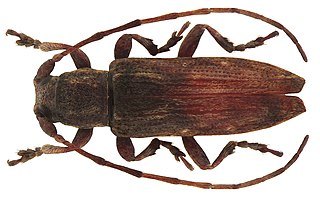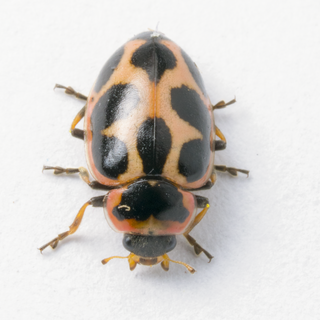
The small dusty wave is a moth of the family Geometridae first described by Franz von Paula Schrank in 1802. It is found throughout Western, Central and Northern Europe. In the north, its range extends as far as Denmark and southern Scandinavia. In the east its range extends as far as Russia. Idaea seriata is replaced by the subspecies Idaea seriata canteneraria, from the north-east of Spain and the central and eastern Mediterranean to the Crimean peninsula, while the western Mediterranean and the Balearic Islands are inhabited by the sister species Idaea minuscularia. Outside Europe it is found in eastern Algeria, Tunisia, Turkey, Cyprus, the Caucasus and the northwest of Transcaucasia. In Morocco and western Algeria, it is replaced by the sister species Idaea minuscularia. In the British Isles it is common in England and Wales but is only found in the eastern half of Scotland and it is rare in Ireland.
Aspilapteryx seriata is a moth of the family Gracillariidae. It is known from South Africa.

Continenticola is a clade that includes the land planarians (Geoplanidae) and the freshwater triclads.

Geoplanoidea is a superfamily of freshwater and land triclads that comprises the species of the Geoplanidae and the Dugesiidae families.
Diplodia seriata is an anamorphic fungus species in the genus Diplodia. It is a cause of bot canker of grapevine in Mexico.

Sybra is a genus of beetles in the family Cerambycidae, containing the following species:

Sybra albomaculata is a species of beetle in the family Cerambycidae. It was described by Breuning in 1939. It contains two subspecies, Sybra albomaculata albomaculata and Sybra albomaculata formosana.
Sybra biguttula is a species of beetle in the family Cerambycidae. It was described by Breuning in 1964. It contains two subspecies, Sybra biguttula biguttula and Sybra biguttula samarensis.
Sybra iconica is a species of beetle in the family Cerambycidae. It was described by Pascoe in 1865. It contains two subspecies, Sybra iconica clarevitticollis and Sybra iconica iconica.

Sybra umbratica is a species of beetle in the family Cerambycidae. It was described by Pascoe in 1865.
Sybra uenoi is a species of beetle in the family Cerambycidae. It was described by Hayashi in 1956. It is known from Japan.
Sybra bioculata is a species of beetle in the family Cerambycidae. It was described by Pic in 1925. It contains four subspecies: Sybra bioculata bioculata, Sybra bioculata quadrinotata, Sybra bioculata sikkimana, and Sybra bioculata tigrina.

Sybra ordinata is a species of beetle in the family Cerambycidae. It was described by Henry Walter Bates in 1873.
Sybra pascoei is a species of beetle in the family Cerambycidae. It was described by Lameere in 1893.
Sybra subfasciata is a species of beetle in the family Cerambycidae. It was described by Henry Walter Bates in 1884.

Melaleuca seriata is a shrub in the myrtle family, Myrtaceae, and is endemic to the south-west of Western Australia. In describing it, John Lindley wrote "Melaleuca seriata, parviceps, and trichophylla, are bushes, every twig of which is terminated by hemispherical heads of a brilliant pink." It is very similar to Melaleuca parviceps.
Dasylophia seriata, the western legume prominent, is a species of moth in the family Notodontidae. It was first described by Druce in 1887 and it is found in North America.
Syneta seriata is a species of leaf beetle. It is found in North America. It feeds on California live oak and California black oak.

Naemia seriata, commonly known as the seaside lady beetle, is a large coccinellid beetle native to North America, and the only species in the genus Naemia. It is found in coastal areas such as beaches, salt marshes, and bay islands on the Atlantic and Pacific coast. This beetle is light brown, yellow, orange, or red in color, with large black spots, often connected along the sides. The pronotum usually has one large central black spot, which is occasionally split into two spots. The body of this species is elongately oval in shape, and between 4 and 6.7mm in length. The two subspecies can be distinguished by markings on the head, with the head of N. seriata seriata being black, while the head of N. seriata litigiosa has a pale triangular marking. Naemia seriata seriata is primarily distributed across Eastern North America, while N. seriata litigiosa is restricted to the American Southwest.

Philonotis seriata is a species of moss belonging to the family Bartramiaceae. It is widely distributed in Europe but it is also found in other parts of the world.










